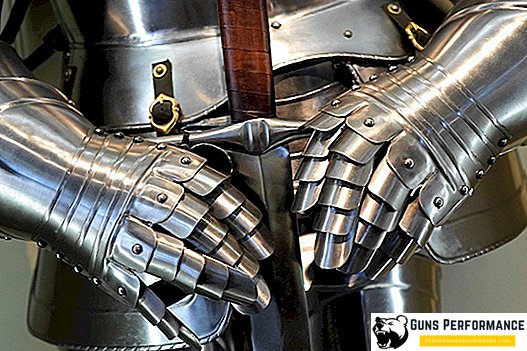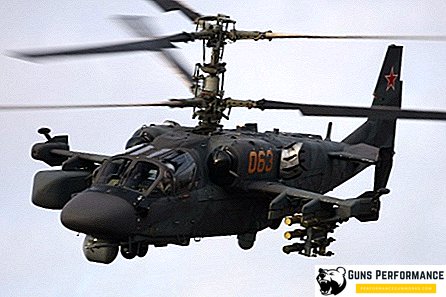
ZSU-23-4 "Shilka" is an anti-aircraft self-propelled unit, created in the mid-60s of the last century, and it is still in service with dozens of armies in the world. “Shilka”, without any exaggeration, can be called a unique weapon, of all the anti-aircraft complexes built after the Second World War, it has the longest and most impressive track record.
The Middle East became the place of baptism for "Shilka", then there was the struggle against American aircraft in Vietnam, numerous conflicts on the African continent and the war in Afghanistan. The Afghan Mujahideen did not have aircraft, so the Shilka was used for other purposes: the ZSU-23-4 was used to support the ground forces and protect the transport convoys. Dushmans called “Shilka” “Shaitan Arba” and were very afraid of her.
ZSU-23-4 is designed to cover ground forces, as well as to combat low-flying targets. "Shilka" was part of the air defense regimental link. Potential opponents highly appreciated the combat effectiveness of this anti-aircraft complex, at one time the Americans and Israelis spent a lot of strength to get it to study.
Currently, the ZSU-23-4 is considered outdated anti-aircraft installation, even in Soviet times, it began replacing the more advanced air-defense system "Tunguska". Despite this, the Shilki are still in service with the armed forces of Russia, Ukraine and several dozen other countries. They are actively used in local conflicts on the territory of the third world countries.
Since the start of mass production, 6.5 thousand units of this weapon have been manufactured.

History of creation
During the Second World War, air attacks during the march became a big problem for the ground forces: attack aircraft, working at low altitudes, caused enormous damage to manpower and military equipment. The Germans, who at the end of the war suffered fierce losses from the actions of Western aviation, developed a small-caliber anti-aircraft installation Kugelblitz ("Ball lightning"). She had two 30-mm guns and a radar, which was used to detect the enemy and aiming at the target. Kugelblitz had a rate of 850 rounds per minute, and even tried to install night vision devices on it. This ZSU was far ahead of its time and for many years became the subject of study and copying.
The Soviet infantry and tankers had no such luxury, and the entire war suffered greatly from German air raids. The situation began to correct after the victory over the Germans.

In 1947, work began on the creation of a 57-mm self-propelled anti-aircraft gun ZSU-57-2. However, at the time of the start of production, this complex was already outdated. He had a too low rate of fire (220-240 rounds per minute), a charger loading and an open tower. The ZSU-57-2 did not have a radar, so the target could only be detected visually, and it lacked a system of protection against weapons of mass destruction. In the meantime, the potential adversary was not asleep: the Americans, having studied the captured samples of the German "Thunderball", in 1956 adopted the 40-mm ZSU with a radar target detection system.
In 1957, in the USSR, work began on the creation of a new self-propelled anti-aircraft gun. Two competing projects were launched at once: the Yenisei ZSU-37-2, armed with two 37 mm cannons and the Shilka ZSU-23-4, with four 23 mm guns. Both anti-aircraft systems were equipped with radar, had a tracked chassis and a system to protect against weapons of mass destruction. Formally, they were designed to solve various problems: the Yenisei provided protection for armored troops, and the Shilka was supposed to cover motorized rifle units. Both complexes had tape feed for the guns and water-cooled barrels.
By 1960, both anti-aircraft complex were ready, and began their tests. ZSU-23-4 "Shilka" was 1.5-2 times more effective than its competitor in shooting at low-flying speed targets, but the "Yenisei" exceeded it in height of defeat. The Commission recommended the adoption of both anti-aircraft complex. However, only Shilka went to the series, work on the Yenisei was suspended.
By 1970, the Shilka became the main mobile anti-aircraft complex CA, it completely replaced the ZSU-57-2 and began to be exported. For the first time, "Shilki" was used during the 1973 Arab-Israeli conflict. Then the Syrian air defense managed to destroy 98 Israeli Air Force aircraft, 10% of which were on account of ZSU-23-4. Dense anti-aircraft fire at low altitudes had a demoralizing effect on Israeli pilots, forcing them to rise to great heights, where they became easy prey for the air defense system.

Shilki were used during the Iran-Iraq war (by both sides), in the final stages of the Vietnam War, during Operation Desert Storm.
In Afghanistan, Soviet troops used ZSU-23-4 to destroy ground targets. The Shilka removed the unnecessary radar and increased the ammunition to 4 thousand rounds. After the appearance of “Shilka” on the battlefield, dushmans usually began to depart.

The main disadvantage of the Shilka was the insufficient power of the 23-mm projectile, did not suit the military and the slant range of the gun, and the insufficient high-explosive effect of the projectiles. When creating a new attack aircraft, the Americans experienced the effect of a captured Shilka captured by Jews during the 1973 war. So there was the famous A-10 "Warthog", which is really well protected from 23 mm anti-aircraft ammunition. The Americans actively advertised this aircraft, calling it invulnerable to Soviet air defense fire.
ZSU-23-4 tried to remake a more powerful 30-mm projectile, but it turned out that it was easier and cheaper to build a new anti-aircraft gun unit than to upgrade the old one. This was done: in 1982, the ZSU "Tunguska" armed with 30-mm automatic guns was put into service.
During the years of operation of this complex, several modifications were developed.

Description of construction
ZSU-23-4 "Shilka" has a welded body with anti-bullet and splinter armor. It is divided into three compartments: the controls, located in the front of the machine, the fighting compartment - located in its center and the power compartment - in the rear part. On the right side of the anti-aircraft installation there are three hatches through which the dismantling and maintenance of the machine’s equipment takes place, as well as the ventilation of the units.
In the tower "Shilki" installed quadruple 23-mm gun AZP-23 "Amur", which works by automating the discharge of powder gases from the barrel. Each barrel is equipped with a cooling system casing and a flame arrester. Chuck feed - side, from a tape link with a warp chamfer. Tapes are in cartridge boxes. The tower has two boxes, a system for cocking anti-aircraft machine guns - pneumatic.
Ammunition "Shilki" consists of two types of 23-mm projectiles: armor-piercing BZT and fragmentation OFZT. BZT armor-piercing ammunition does not have an explosive and contains only incendiary tracing composition. OFZT shells have a fuse and self-killer (lasts 5-10 seconds). In the tape for four bullets OFZT goes one BZT.
Targeting is done with the help of hydraulic drives, possibly manual guidance. The rate of fire - 3400 shots per minute.
In the instrument compartment of the tower there is a radar-instrumentation complex, with the help of which the target is searched, it is accompanied and the projectile trajectories and the necessary anticipation are calculated. The detection range of airborne objects is 18 km.
The Shilka anti-aircraft complex can fire at air targets in several modes:
- in automatic;
- in semi-automatic;
- on the perspective rings;
- by memorized coordinates;
- on ground targets.
Automatic shooting mode is considered the main one.
The radar instrument cluster consists of the following elements:
- lamp radar 1RL33M2;
- analog calculating device;
- sight device;
- stabilization systems.
The combat vehicle is equipped with a radio station R-123M and intercom TPU-4.
ZSU-23-4 "Shilka" is equipped with a diesel engine В6Р. It has six cylinders, liquid cooling and a maximum power of 206 kW. The machine has two aluminum fuel tanks with a total volume of 515 liters. That was enough for 400 km of the course. Additional installation is designed to power on-board electronics.
The running gear of the car consists of two driving wheels, two guide wheels and twelve road wheels with rubber-coated rims. Suspension - independent torsion bar.
The crew is protected against weapons of mass destruction by creating overpressure in the fighting compartment and air purification.
Modernization of the Shilka anti-aircraft complex went along the path of improving its ability to detect air targets, as well as increasing the security of the complex. In the mid-1970s, the Ovod-M-SV complex was created to control the firing of anti-aircraft installations at the regimental level. It consisted of the Luk-23 radar and an automated fire control system.
In the mid-90s, the Shilka-M4 and Shilka-M5 versions appeared with more advanced fire control systems. To destroy armored targets was created 23-mm sub-caliber ammunition.
In 1999, a modification of the Shilka was presented to the general public, on the tower of which the Igla MANPADs were additionally installed.

Advantages and disadvantages
One of the main drawbacks of the Shilka anti-aircraft installation is its heavy, complicated and low-power undercarriage. Its repair and maintenance is a difficult and time consuming business. To get to some of its nodes, it is necessary to dismantle many units, drain the oil and coolant. Capacity 240 liters. p., which is capable of the engine "Shilka", is insufficient for its weight, so the machine is slow and low-maneuverable.
In addition, in the power plant and the chassis of the machine, other structural errors and omissions were made, resulting in frequent breakdowns of an anti-aircraft gun.
Radar "Shilki" has a small range and quite capricious in setting. It should also be added that the car provided the minimum level of comfort for the crew.
However, all of the above disadvantages are leveled by the highest level of reliability of the anti-aircraft guns of the complex. If they are properly assembled and installed, the cooling system is flooded with water according to the norms, then the probability of failure or failure during shooting was practically excluded.
Even today, the Shilka can pose a serious danger to enemy aircraft and helicopters, if, of course, they are not flying too high.

Specifications
The following are TTX ZSU-23-4 "Shilka".
| Year of adoption | 1962 |
| Sizes of the affected area, km: | |
| - by distance | 0-2,5 |
| - in height | 0-1,5-2 |
| Target speed, m / s: | |
| - when shooting towards | 450 |
| - when shooting in pursuit | 300 |
| Amount and caliber of guns, mm | 4x23 |
| Projectile weight, kg | 0,19 |
| The initial velocity of the projectile, m / c | 1000 |
| The possibility of shooting in motion | Yes |
| All-weather performance | Yes |
| Mass, t | 20,5 |
| Calculation, pers. | 4 |












